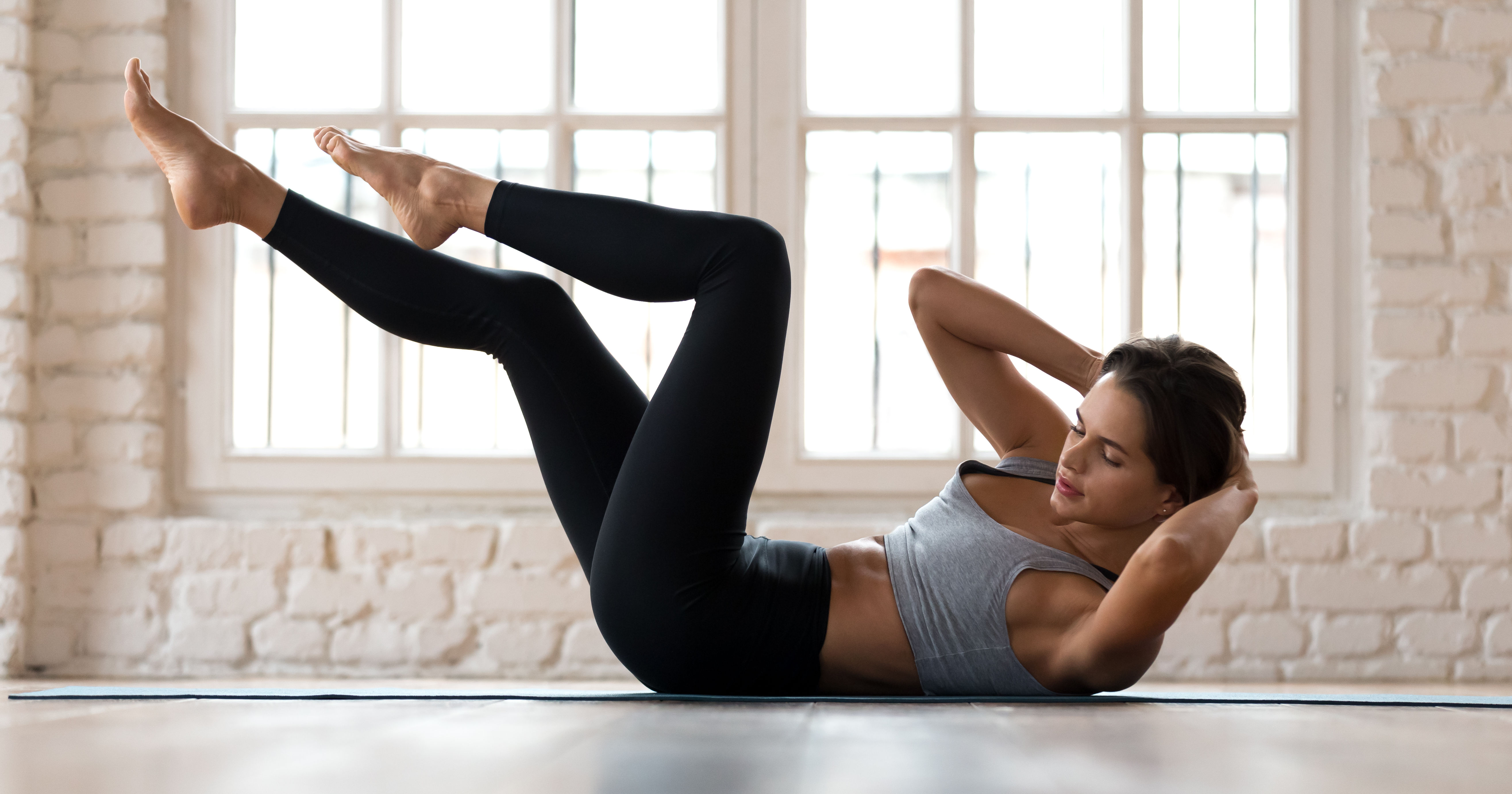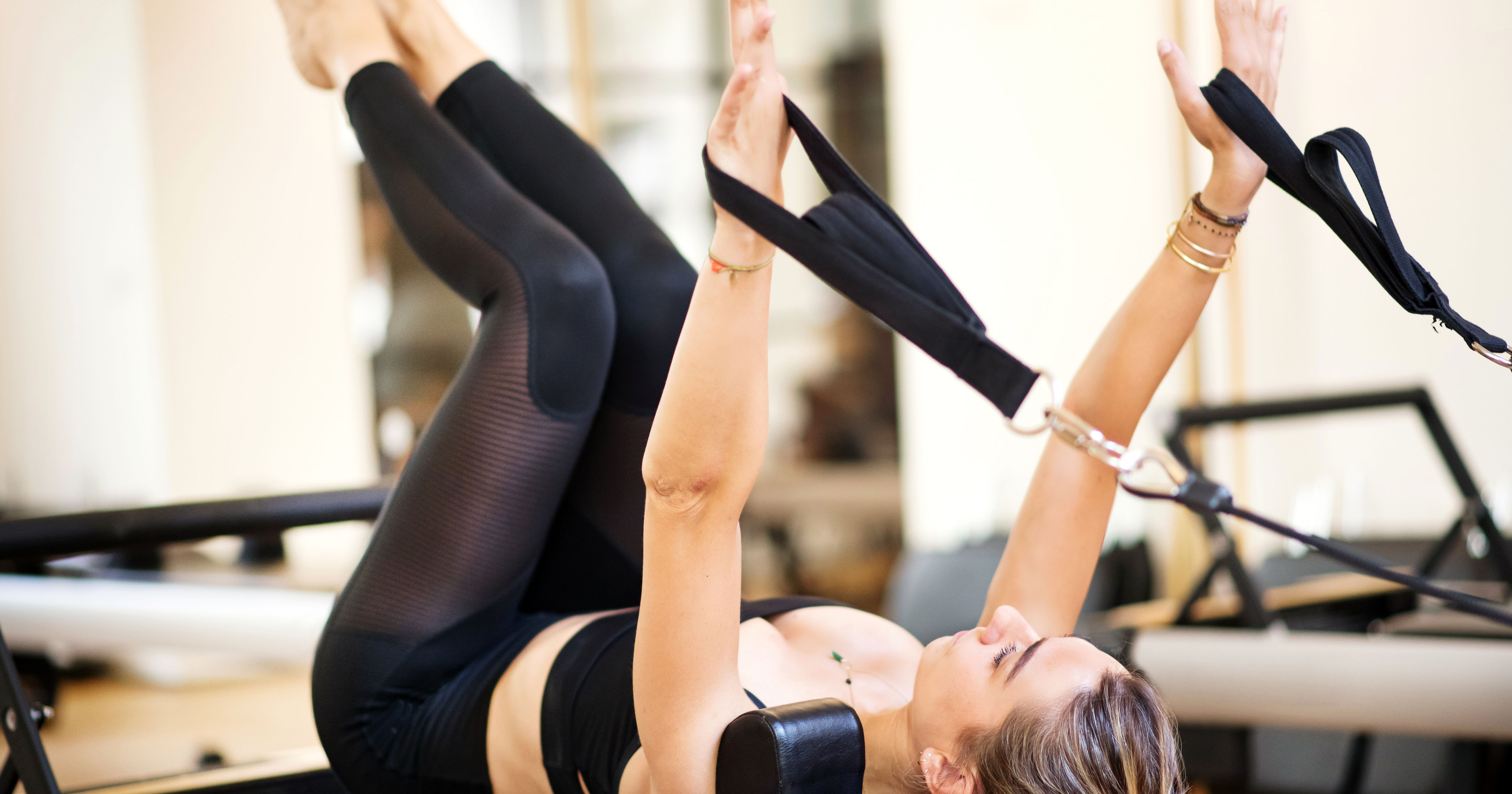Gym Ball Strengthening Exercises
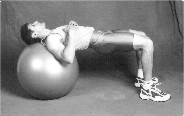 This section is designed for the person with long standing back pain or pain that was sharp and is now more moderate in nature. Before beginning this intermediate program it is strongly suggested that you are proficient with the exercises found on the Acute Low Back Pain Page of the Tereo Chiropractic website. This will decrease any chance of exercise induced flare-up.
This section is designed for the person with long standing back pain or pain that was sharp and is now more moderate in nature. Before beginning this intermediate program it is strongly suggested that you are proficient with the exercises found on the Acute Low Back Pain Page of the Tereo Chiropractic website. This will decrease any chance of exercise induced flare-up.
This section of the website is divided into two. The Moderate Back Pain Exercises page contains all the information, exercises and activities pertaining to this rehabilitation track. The second page titled Quick Start contains the exercises only. This makes for a printer-friendly version of the program.
Moderate or Chronic - Lower Back Pain
This section is designed for the person with long standing back pain or pain that was sharp and is now more moderate in nature. Before beginning this intermediate program it is strongly suggested that you are proficient with the exercises found on the Acute Low Back Pain Page of the Tereo Chiropractic website. This will decrease any chance of exercise induced flare-up.
We will introduce some basic activities using the Gym Ball and Foam Roller. The aim of these activities are to develop coordination, endurance, and to strengthen the lower back, hips, and legs without increasing pain.
The Gym Ball should be properly inflated prior to use (see equipment). To familiarize yourself with the ball, a carpeted open area is best. Kneel in front of the ball with your knees spread wider than shoulder width. Place the hands on each side of the ball and slowly lower your chest onto it. When comfortable, roll forward, transferring body weight from the knees onto the ball. The chest and stomach are supported by the ball with the legs spread-out for balance and the toes firmly in contact with the ground. Rock slowly back and forth until you feel confident in your balancing skills.
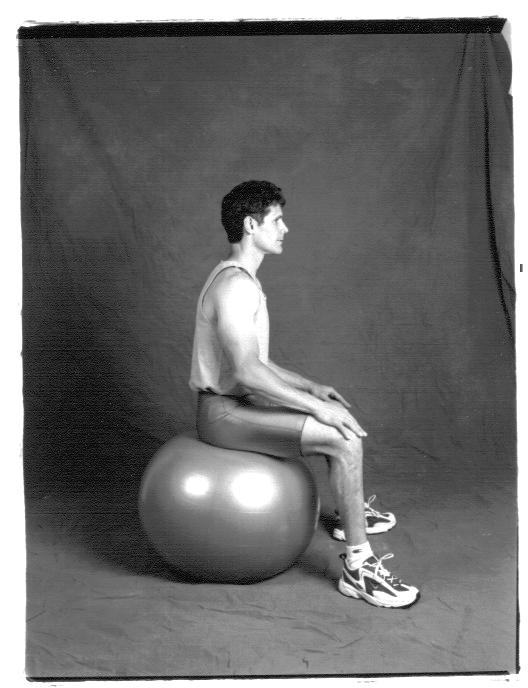 Sitting
Sitting
Sitting on the ball is the next activity introduced to familiarize yourself with exercising on an unstable surface. You will come to realize that using the ball increases balance, coordination, and lower body strength.
To sit on the ball, take a wide stance (feet wider than shoulder width) with your back to the ball. Bend at the hips and knees as you would to sit in a chair. Contact the ball with your hands to stabilize this activity. Lower yourself onto the ball and sit erect. The seated position is the starting point for many stretches and strengthening exercises.
The ball can be used in place of a chair while eating, using the computer, reading, or watching television. In other words, you can continue your strengthening program while doing other things. There are several stretches which can be performed on the ball. Several exercises will be introduced in the following pages. These activities were chosen for their ease and safety of performance.
Pelvic Tilt
The purpose of this activity is to increase flexibility to the back and hips while developing an increase in body awareness and balance. As with any stretch, this activity will help warm the muscles as you prepare to exercise.
To perform this activity, sit on the ball with feet placed flat on the floor, wider than shoulder width. While maintaining a seated position, gently roll the ball forward and back, letting your pelvis rock with the ball. As the ball rolls forward, slightly arch the lower back, letting the hips follow with the rhythm of the ball.
As the ball rolls back, slightly round the back. Repeat 10 times as a warm up and cool down.
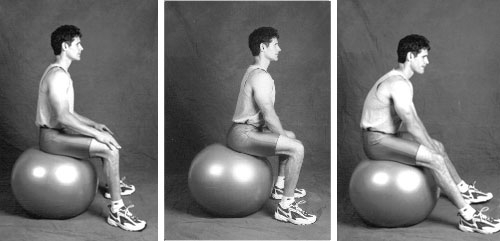
Stretching the Lower Back
Stretching the low back can be achieved two ways; by bending forward at the hips which is called flexion and, by bending the spine backwards, known as extension. Careful experimentation with each of these methods will help to determine which method is best for your condition. In general, stretching in both directions should be beneficial.
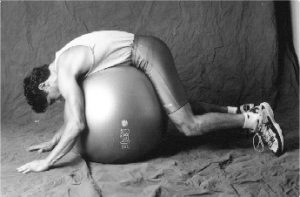 Stretching the Low Back in Flexion
Stretching the Low Back in Flexion
Flexion means that a part of the body is bending. In the case of the lower back, you will be stretching the back by bending over the ball while on your chest and stomach. To perform the forward stretch, kneel in front of the ball.
Place your hands and chest on the ball and roll forward until the ball supports the body and both the hands and feet are in contact with the floor to help maintain balance. Gently roll back and forth to stretch the different muscles of the back. Be careful with this activity, over-stretching can cause pain.
The first time out, stretch for a maximum of 15 to 30 seconds, working up to longer periods as stability permits.
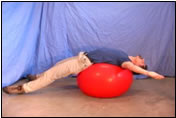 Stretching the Low Back in Extension
Stretching the Low Back in Extension
Extension is the opposite of flexion. With this activity, the body will be bending backward. To begin, sit on the ball and slide down until you are lying flat. With your back on the ball and feet on the floor, reach up and back with your hands stretching the stomach and back. DO NOT OVER-STRETCH. You can hurt yourself very easy in this position. Begin with a very short test. 15 to 30 seconds working up to a longer stretch with time.
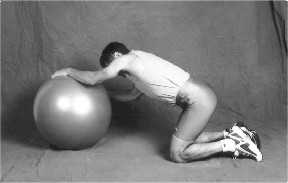 Rotation Stretches for the Back
Rotation Stretches for the Back
To perform this exercise, kneel in front of the ball, sitting back on your heels. Hold onto the ball with outstretched hands, slowly rolling the ball side-to-side while stretching the back.
When performing the rotational stretch, use extra care not to aggravate the lower back.
 Ball Squats
Ball Squats
Ball Squats are an excellent exercise to strengthen the leg and hip musculature which will help to stabilize the low back.
To perform the ball squats find a sturdy wall. Hold the ball to the small of your back and a wall. Walk out one step so you are leaning on the ball. Position your feet wider than shoulder width for balance. As your skill level increases you can use a closer foot position to strengthen different muscle fibers.
Cross your arms across the chest. Take in a breathe, slightly tighten the abdominal muscles, and slowly exhale as you bend at the hips and knees, lowering down until the thighs are parallel to the floor (like you are going to sit in a chair). Slowly come back to the starting position being careful not to snap the knees into a locked position. Repeat 10 times.
 Hip & Back Flexor
Hip & Back Flexor
The aim of this activity is to build strength and endurance to the lower back and gluteal (buttock) muscles. To perform this exercise, lie on your back with the legs up on the ball and arms outstretched to the sides.
The Hip and Back Flexor exercise strengthens the lower back and buttocks musculature. Slowly raise the hips up, squeezing the gluteal muscles (buttocks muscles) as you reach the top. Slowly return to the starting position. Repeat 10 times.
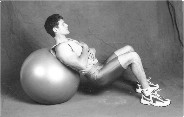 The Ball Bridge
The Ball Bridge
The Ball Bridge is another great way to strengthen the lower back and buttocks musculature. This exercise can be used in addition to or in place of the Hip and Back Extensor exercise.
To perform The Ball Bridge, sit on the Gym Ball and roll down until it is centered between the shoulder blades. The knees are bent at a 90 degree angle and the feet (slightly wider than shoulder width) are flat on the floor, and the body is straight, like a table top. Slowly lower the hip area. Hold, then slowly return to the top position squeezing the gluteal muscles. Repeat ten times. The Ball Bridge strengthens the back and hip musculature.
 Leg Raiser
Leg Raiser
The Leg Raiser is a solid strengthening exercise for the lower back, hip, and leg musculature. To perform this activity kneel in front of the ball with your chest resting on it and the hands out to the side on the floor for support. Slowly raise one leg up and back until the buttock and back muscles are contracted. Slowly lower back to the starting position. Repeat with the other side. Complete ten repetitions.
The Leg Raiser strengthens the back, hip, and leg muscles.
.jpg) Back Extension
Back Extension
To perform this lower back and gluteal muscle toning exercise kneel in front of the ball. Slowly roll forward, until you are resting with the elbows on the floor and the pelvic and abdominal areas on the ball.
The elbows should be held out to the sides as far as possible to help with balance. Keeping the knees straight, slowly raise the legs together until the gluteal and lower back musculature contracts. Slowly lower the legs to the starting position. Repeat ten times.
 Crunches
Crunches
Crunches are an efficient abdominal strengthening exercise. The abdominal (stomach) muscles are used to help hold the body straight which is why keeping them strong is very important. There are several ways to perform crunches and following are two versions which are perfect for the intermediate level of back conditioning.
Ball Crunches
Ball crunches build strength, endurance, and coordination and the curved surface of the Gym Ball provides an excellent support to maximize the effect of the abdominal crunch.
To begin, sit on the Gym Ball and slowly roll down until the small of the back is resting on the ball. Support the head and neck by lacing the fingers together at the base of the head, keeping in mind not to pull with the arms during exercise. Roll your torso up and forward feeling the stomach muscles contract. Hold for a moment, then slowly return to the starting position. Repeat 10 times.
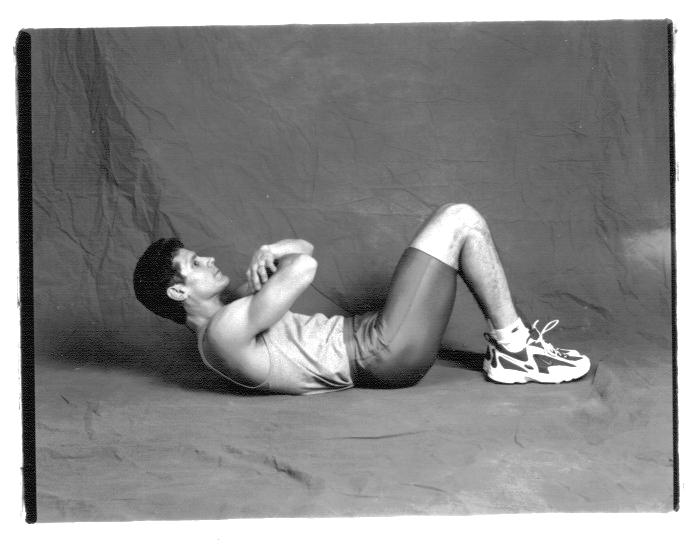 Bent Knee Crunches
Bent Knee Crunches
can be used in addition or in place of the ball crunches. This activity does not require balancing skills as does any ball supported activity. To begin, lay on the floor with the legs up on the ball (knees and hips bent to 90 degrees) and your hand supporting the head or neck. Slowly roll up, flexing the abdominal muscles. Hold briefly then slowly return to the starting position. Repeat ten times.
Foam Roller Exercises
The main use of the foam roller is for the development of balance and coordination. Strength and endurance are additional benefits which will be derived from incorporating this piece of equipment in a regular fitness program.
For the intermediate level of exercise, there are two activities using the foam roller which are reasonably safe. The Prone Leg Raiser and The Balance Beam. These activities are optional and if you are experiencing back pain on a workout day, they should not be performed that day.
 The Balance Beam
The Balance Beam
The Balance Beam is a simple activity to help with balance. Place the roller on a carpeted floor. Make sure that you have something sturdy to hold onto for balance. Stand on the ball about shoulder width apart. Start with a brief period of time and work up to 2 minutes.
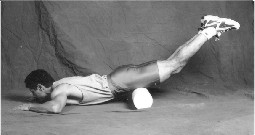 Prone leg raisers
Prone leg raisers
(Prone means lying face down) To perform the Prone Leg Raiser, lay face down with the hips placed 90 degrees to the roller. Slowly raise one leg up, (knee straight) flexing the gluteal and back muscles. Hold, then slowly return to the starting position. Repeat on the opposite side. This exercise should be performed for ten reps.
Floor Exercises
These activities are performed on the floor without the use of equipment.
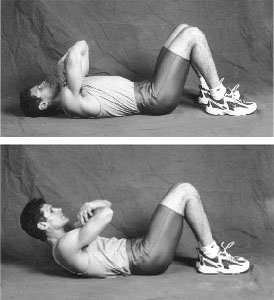 Floor Crunches
Floor Crunches
Floor Crunches are similar to the ball crunches and as the name suggests are performed on the floor with the knees straight or bent. To perform this exercise, lie on your back in the bent knee position with the feet flat on the floor. Support the neck by placing the hands behind it or on the back of the head. Be sure not to pull on the head or neck during the activity. Next roll the pelvis so the back is flat to the floor and the stomach muscles are tight. Gently press your knees together so the inner thigh muscles are slightly contracted (tight). Be sure to hold the stable pelvis and tight knee position throughout the exercise.
Breathe in to prepare for movement. Breathe out as you slowly roll the shoulders off the ground. When the shoulder blades are off the ground, hold for a moment and slowly lower back down breathing in as you go down. Repeat ten times. Crunches help to develop dynamic abdominal strength.
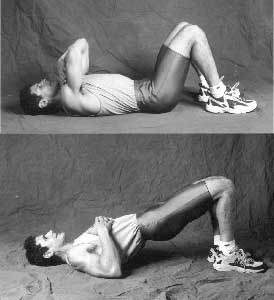 Gluteal Flexor – The Floor Version
Gluteal Flexor – The Floor Version
The aim of this activity is to build strength and endurance to the lower back and gluteal (buttock) muscles. To perform this exercise, lie on you back with knees bent and feet flat on the floor. Slowly raise the hips up, squeezing the gluteal muscles as you reach the top. Slowly return to the starting position. Repeat 10 times. The Gluteal Flexor exercise addresses the back and gluteal musculature while on a stabile surface.
 Side raises / Abductor Lift
Side raises / Abductor Lift
This activity strengthens the muscles of the outer thigh (abductor muscles). Other muscles benefitted are the hip, abdominal, and those of the lower back. To perform the exercise, lay on your side with the bottom leg slightly bent at the hip and knee for stability. Tighten the abdominal musculature slightly. Raise the top leg so that it is in line with the hip. Lower slowly to starting position. Repeat ten times per side.
Inner Thigh Lifts / Leg Adductors
This exercise will strengthen the inner thigh muscles called the adductors. Abdominal, hip, and back muscles will also benefit. To perform the activity lay on your side. Bend the top leg at the knee and hip, resting the foot of the top leg on the floor for support. The bottom leg is straight with the toes softly pointed. Slowly raise the bottom leg toward the top. Lower to starting position and repeat for a total of ten times per side.
Floor Oriented Stretches
Stretching helps to prepare the body for exercise. The slow, controlled movement allows the muscles, tendons, and ligaments to warm up becoming, more fluid and flexible. This can minimize the risk of injury or the chance of aggravating an unstable back.
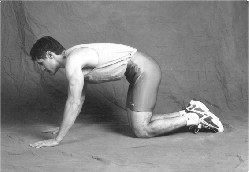 The Cat Stretch
The Cat Stretch
The Cat Stretch is a basic Yoga movement. To start, kneel on all fours with the hands placed slightly wider than the shoulders. If you have wrist problems, rest on your knuckles. If not, the fingers should be pointing straight ahead. The knees should be spaced about as wide as your hips and the toes should be pointing backwards. The back should be flat, like a table. The first part entails rolling the pelvis up and back like a Halloween Cat while contracting the abdominal muscles.
Breathe out, bringing the head to the chest as you complete the initial part. Return to the starting position. The second part requires rolling the pelvis down and forward so the mid-section hangs like an old horse. Breathe out as you move. Repeat the complete movement ten times.
 Knee to Chest Lower Back Stretch
Knee to Chest Lower Back Stretch
This stretch will increase the flexibility of the lower back, hips, and thigh musculature while warming them up for activity. Perform all stretches slowly. Breath in as you prepare for movement. Breath out with movement.
To perform the Knee-to-Chest Lower Back Stretch, lay face up and grasp one of your thighs with both hands and gently pull the leg towards the chest. This should be a pain-free stretch. If any pain is experienced, please back off on the pressure. Hold the stretch for 3 to 5 breaths. Repeat with the other leg. Each leg should be stretched five times.
Next grasp the right thigh with the right hand and the left thigh with the left hand. Gently pull both thighs toward the chest, hold for 3 to 5 breathes, then slowly lower back to the resting position. Repeat 5 times.
Leg Stretch
The musculature, tendons, and ligaments of the leg can be stretched many ways. The use of a chair, a stool, or in this case, a towel. To stretch the hamstring and calf muscles lay on your back. Hold the ends of a towel in each of your hands and loop the middle over one of your feet. Straighten the leg and gently pull back on the towel.
Hold for 3 to 5 breathes. Repeat with the other leg for a total of 3 to 5 times per leg. Many items found around the house can serve as a support when stretching the leg musculature. When stretching, be sure that you can maintain balance during the activity to avoid injury.

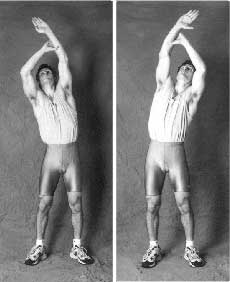 Side Reaches
Side Reaches
Side reaches can be performed in a standing or seated position and are a good stretch for the lower back musculature. When performing the side stretch use slow gentle movements, never jerk or use force. This could lead to injury.
Standing Side Reaches Stand with the feet slightly wider than the shoulders, the knees are slightly bent (not locked), the back is flattened, and the abdominal muscles slightly flexed. Raise the arms above the head grasping the right wrist with the left hand and slowly pull to the left side. Gently stretch and hold for 3 to 5 breathes. Next grasp the left wrist with the right hand and repeat on the right for a total of 3 to 5 times per side.
Seated Side Reaches are performed the same as described above. While seated, keep the knees and feet wider than the shoulders for stability.
HOW OFTEN SHOULD I WORK OUT?
The presentation of these numerous exercises probably has you wondering, “How often should one work out?” The answer is simple, EVERY DAY! A healthy back requires movement – but each work out does not have to be a Schwarzenarian effort. Successful recovery from back pain and a lifestyle change requires persistence. The investment of time in a daily routine will pay off through the increased quality of your life.
NOW THAT I HAVE THIS EXERCISE INFORMATION . . .WHAT DO I DO WITH IT?
Following are seven different work-out programs utilizing the exercises and activities found in this chapter. These routines can be performed on any day and in any order. Performing a variety of exercises will benefit the back by stimulating muscle fibers, ligaments, and tendons in different directions.
Each work-out will flow from a warm up section to strengthening exercises and ending with cool down activities. It is recommended that once you choose one of the seven routines that you follow through to completion in the order the activities are listed.
During the first few weeks of the program you will be developing coordination and endurance. Each day perform the routine you choose only once. Into the second or third week you can perform the routine twice.
WORK OUT NUMBER ONE
| Exercise / Activity | Repetitions / Duration |
| Knee to Lower Back Stretch | 5 times |
| Ball Stretch in Flexion | 15 to 30 sec. 3 – 5 times |
| Ball Stretch in Extension | 15 to 30 sec. 3 – 5 times |
| Ball Squats | 10 times |
| Kneeling Leg Raiser | 10 times per leg |
| Gluteal Floor Flexor | 10 times |
| Side Raises / Abductor Lift | 10 times per leg |
| Ball Crunches | 10 to 20 times |
| Rotational Stretch | 5 times per side |
| Stretch in Flexion | 15 to 30 sec. 3 – 5 times |
| Balance on the Foam Roller | 30 to 120 seconds |
WORK OUT NUMBER TWO
| Exercise / Activity | Repetitions / Duration |
| Ball Pelvic Tilting | 10 to 20 times |
| Ball Stretch in Flexion | 15 to 30 seconds 3 – 5 |
| Ball Rotational Stretch | 5 times per side |
| Ball Squats | 10 times |
| Ball Bridge | 10 times |
| Back Extension | 10 times |
| Inner Thigh Lifts / Leg Adductor | 10 times per leg |
| Bent Knee Crunches | 10 to 20 times |
| Ball Stretch in Extension | 15 to 30 sec. 3 – 5 times |
| Standing Side Stretch | 10 times per side |
| Leg Stretch | 15 to 30 sec. 3 – 5 times |
WORK OUT NUMBER THREE
| Exercise / Activity | Repetitions / Duration |
| Knee to Chest Back Stretch | 5 times |
| Ball Pelvic Tilting | 20 times |
| Seated Side Stretches | 10 times per side |
| Ball Squats | 10 times |
| Prone Leg Raiser | 10 times per leg |
| Straight Leg Crunches | 10 to 20 times |
| Side Raises / Abductor Lift | 10 times per leg |
| Ball Crunches | 10 to 20 times |
| Rotational Stretch | 5 times per side |
| Stretch in Flexion | 15 to 30 seconds 3 – 5 times |
| Stretch in Extension | 15 to 30 sec. 3 – 5 times |
WORK OUT NUMBER FOUR
| Exercise / Activity | Repetitions / Duration |
| Knee to Lower Back Stretch | 5 times |
| Ball Stretch in Extension | 15 to 30 sec. 3 – 5 times |
| Balance on the Foam Roller | 30 to 120 seconds |
| Ball Squats | 10 times |
| Back Extensions | 10 times |
| Inner Thigh Lifts / Leg Adductor | 10 times per leg |
| Side Raises / Abductor Lift | 10 times per leg |
| Floor Crunches | 10 to 20 times |
| Rotational Stretch | 5 times per side |
| Stretch in Flexion | 15 to 30 sec. 3 – 5 times |
| Ball Pelvic Tilting | 10 to 20 times |
WORK OUT NUMBER FIVE
| Exercise / Activity | Repetitions / Duration |
| Stretch in Flexion | 15 to 30 sec. 3 – 5 times |
| Ball Stretch in Extension | 15 to 30 sec. 3 – 5 times |
| Rotational Stretch | 5 times per side |
| Ball Squats | 10 times |
| Ball Bridge | 10 times |
| Prone Leg Lift | 10 times per leg |
| Back Extension | 10 times |
| Ball Crunches | 10 to 20 times |
| Balance on the Foam Roller | 30 to 120 seconds |
| Standing Side Stretch | 10 times per side |
| Knee to Chest Back Stretch | 5 times |
WORK OUT NUMBER SIX
| Exercise / Activity | Repetitions / Duration |
| Rotational Stretch | 5 times per side |
| Knee to Chest Back Stretch | 5 times |
| Seated Side Stretch | 10 times per side |
| Ball Squats | 10 times |
| Ball Crunches | 10 to 20 times |
| Gluteal Floor Flexor | 10 times |
| Side Raises / Abductor Lift | 10 times per leg |
| Bent Knee Crunches | 10 to 20 times |
| Standing Side Stretches | 10 times per side |
| Ball Stretch in Flexion | 15 to 30 sec. 3 – 5 times |
| Ball Stretch in Extension | 15 to 30 sec. 3 – 5 times |
WORK OUT NUMBER SEVEN
| Exercise / Activity | Repetitions / Duration |
| Ball Stretch in Flexion | 15 to 30 sec. 3 – 5 times |
| Rotational Stretch | 5 times per side |
| Ball Pelvic Tilting | 10 to 20 times |
| Ball Squats | 10 times |
| Ball Bridges | 10 times |
| Side Raises / Abductor Lift | 10 times per leg |
| Ball Crunches | 10 to 20 times |
| Inner Thigh Lift / Leg Adductor | 10 times per side |
| Seated Side Stretch | 10 times per side |
| Stretch in Flexion | 15 to 30 sec. 3 – 5 times |
| Knee to Chest Stretch | 5 times |

